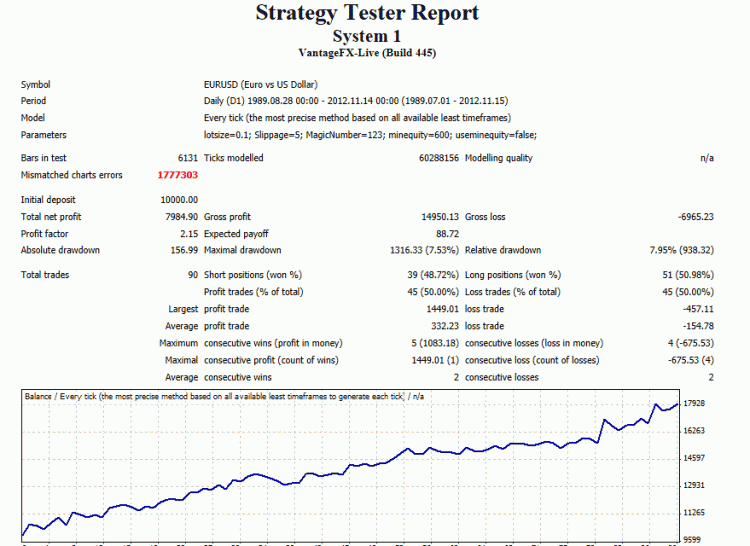 ubzen:
ubzen:It depends. I don't see draw-down% or #-of-trades in the list. If it's a fairly active system with relative draw-downs <33% then perhaps compounding [increasing lot size as account grows] might help your % return yearly.
Here is a report from my first system. It appears to do quite well but only makes 7000 on a 10000 account from 1989 until last month. The drawdown is only around 7% which is fine but is it right that you should assume that the drawdown you encounter in testing is half what you can expect in live trading? On the face of it I could double this up quite nicely and still only expect a 30% drawdown live.
How do you approach this?
Have you looked at past results of the automated trading championship? The records there give hundreds of examples of profit factors from (semi) live trading. Judge for yourself whether you consider those to be good or bad.
(Remember though that strategies entered into the championship can afford to follow a more risky strategy since participants do not risk any real money, and the EAs only have to survive for a few months).
Have you looked at past results of the automated trading championship? The records there give hundreds of examples of profit factors from (semi) live trading. Judge for yourself whether you consider those to be good or bad.
(Remember though that strategies entered into the championship can afford to follow a more risky strategy since participants do not risk any real money, and the EAs only have to survive for a few months).
Ok, I'll have a look, thanks.
Here is a report from my first system. It appears to do quite well but only makes 7000 on a 10000 account from 1989 until last month. The drawdown is only around 7% which is fine but is it right that you should assume that the drawdown you encounter in testing is half what you can expect in live trading? On the face of it I could double this up quite nicely and still only expect a 30% drawdown live.
How do you approach this?
Well it took 90 trades in 23 years so that would mean quite a long time of demoing! I have run the system in visual mode and I see no reason why the trades taken on the tester would not have been taken in live trading.
My intention is to run a few lowish drawdown systems on the same account to aim to achieve a return in the region of 20 to 50% a year without going backwards by more than about 30%.
It's interesting, and perhaps slightly worrying, that the trend following systems I have tested (all very basic setups) seem to only make money on eurusd daily charts.
Well it took 90 trades in 23 years so that would mean quite a long time of demoing! I have run the system in visual mode and I see no reason why the trades taken on the tester would not have been taken in live trading.
My intention is to run a few lowish drawdown systems on the same account to aim to achieve a return in the region of 20 to 50% a year without going backwards by more than about 30%.
It's interesting, and perhaps slightly worrying, that the trend following systems I have tested (all very basic setups) seem to only make money on eurusd daily charts.
Umm, yea welcome to the club. The best traders I see in magazines usually return around 30% annually. True, trend following systems are very difficult to make work with other pairs. The biggest benefit for trend following system is usually the fact that they'll lose your capital slower. Many traders like this because it gives them a chance to re-optimize or switch to a different system when their system is no longer working.
So I am working along the right lines and in the right direction? My goals are realistic and achieveable? What about the max expected drawdown question I posed earlier, am I right to expect a drawdown double the max drawdown in testing or would that lead me to be too conservative and under utilise my capital?
Well it took 90 trades in 23 years so that would mean quite a long time of demoing! I have run the system in visual mode and I see no reason why the trades taken on the tester would not have been taken in live trading.
1) So I am working along the right lines and in the right direction? Yes.
2) My goals are realistic and achievable? Yes.
3) I right to expect a drawdown double the max drawdown?
No, Draw-Down can go lower. [Don't trade money you cannot afford to lose].
4) ..would that lead me to be too conservative and under utilize my capital?
It's perfectly fine to under-utilize the capital. The real question is would you be happy with the returns?
Historical profit is not indicative of Future results. One selects a trading-system because it didn't lose in the past . . . Not because it'll win in the future.
- Free trading apps
- Over 8,000 signals for copying
- Economic news for exploring financial markets
You agree to website policy and terms of use
I seem to be able to code a number of different ea's that have a profit factor between 1.5 and 2.1 on eurusd daily charts but not any higher and not on very many other pairs. If I test these over the last 20 or so years of data they double the starting account but don't make much more. Doubling an account in 20 years is actually a relatively small % return per year.
What % return per year per system would you deem acceptable and what profit factor do you look for? Do you calculate any other profit/loss related ratios like sharpe ratio or ulcer index?